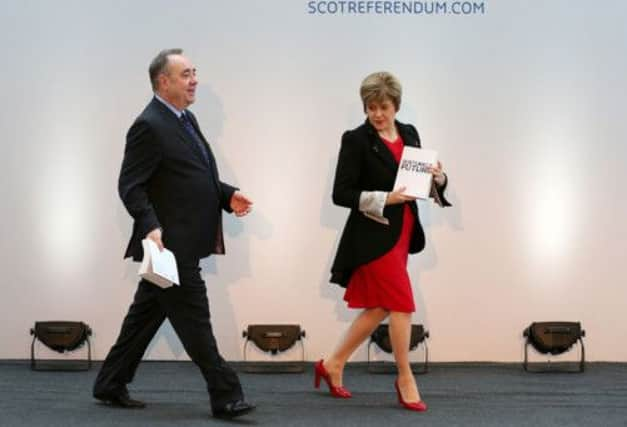Leader: SNP throws down gauntlet to Better Together


First Minister Alex Salmond launched the white paper at an event in the Glasgow Science Centre that was low-key, sober and measured. Unlike the launch of the Yes Scotland campaign last year, there were no celebrities, no emotional folksongs, no razzmatazz. Instead, this event’s power lay in its business-like delivery, seriousness of intent and meticulous attention to detail. Mr Salmond and Nicola Sturgeon were, as one might expect, masters of the material.
Within its covers are answers aplenty for those with questions about Scottish independence. There are details on issues as diverse as applications for university (according to the document an independent Scotland would still use the UCAS admissions system) to vehicle licensing (Scotland would still use the DVLA) that have become familiar tropes in independence debates down the years. Every pub in Scotland should have a copy, for the judicious ending of saloon bar arguments between now and polling day.
Advertisement
Hide AdAdvertisement
Hide AdBut in some areas the answers provided in Scotland’s Future fall some way short of being definitive. Unfortunately for the SNP, these areas include some of the most fundamental aspects of statehood. For the most part, the white paper openly acknowledges when a particular outcome is simply an “aim”. It makes clear it is an advocacy document. But in other areas it is guilty of trying to give the impression that a favoured outcome is a foregone conclusion, when even the slightest degree of scepticism would reveal that it is, at most, a best guess or a high hope. There are too many unsupported assertions in this document, and they let it down.
Take, as an illustrative example, the tricky issue of how an independent Scotland would gain entry to the European Union. The white paper gets round the troublesome view of EU president José Manuel Barroso by saying his objection to automatic entry is based on an erroneous assumption about the article of the EU constitution under which an independent Scotland would be seeking its place.
But the white paper then asserts, on Page 217: “We will not be taken out of the EU against our wishes as may turn out to be the case if we are not independent.” This is politics, not policy. There is no coldly rational justification for such a definitive statement.
SNP ministers may honestly believe that Scotland will be a continuing member of the EU. And it may well be the case that an independent Scotland’s passage into the EU would be smooth, with every country agreeing without a murmur to the necessary changes to the appropriate treaties, making no objection to Scotland’s desire for the same advantageous opt-outs negotiated by the UK under Margaret Thatcher. But they cannot say this for sure.
A similar point can be made on the currency issue. Scottish ministers may be utterly convinced in their belief that Whitehall would come to the inescapable conclusion that a sterling zone would be in everyone’s best interests following the break-up of the UK. And they may be right. But how can anyone be sure?
The reality is that, on many of these issues, there may never be a definitive answer before polling day next September. The course of the political river can change direction for many unpredictable reasons. The personalities change; the ideologies of the parties in power morph as required by circumstance or the whim of the electorate; the imperatives of self-interest are ever-shifting; unforeseen events can destroy years of assumptions in an instant.
The decision on whether to vote Yes or No to Scottish independence will always, therefore, be a leap of faith to some degree. But the void we are invited to cross can certainly be narrowed. If we cannot have certainty, at least we can make as informed a choice as humanly possible. And this is where yesterday’s white paper publication is a gauntlet thrown down to the parties in the Better Together campaign, and to ministers in the United Kingdom government, and to the EU.
For Scots to be in possession of as much information as possible, UK government ministers have to be more forthcoming. Would they support an independent Scotland’s bid to enter the EU? And what would be the considerations in contemplating a sterling zone? They have a duty to tell us more. In the meantime, we would urge every Scot to take on some new bedtime reading.
SEE ALSO:
Advertisement
Hide AdAdvertisement
Hide Ad